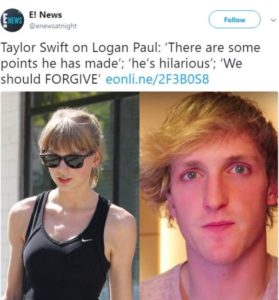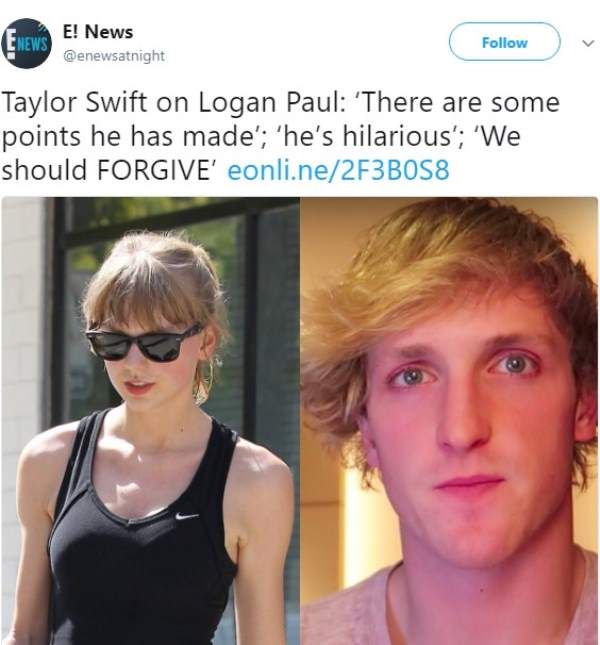On the evening of Jan. 7, I was scrolling through my Twitter feed when I saw something that stopped me dead in my tracks. I stared at the headline, not quite able to wrap my head around it: “Taylor Swift on Logan Paul: ‘There are some points he has made’; ‘he’s hilarious’; ‘We should FORGIVE.'” This headline was tweeted from a page called “E! News,” with the username @enewsatnight. The reason it showed up on my timeline, however, was that the initial tweet had been quoted in a tweet by a woman with the username @Kynddaaa who simply said, “bitch we hate you too lmaoo.”
Apparently, hating Taylor Swift is a popular thing on twitter because at the time I first viewed the tweet, it had been retweeted 17,000 times and liked by almost 50,000 people. By the time this post was taken down by @Kynddaaa, it had received 73,100 retweets and 185,000 likes. A troubling prospect, considering Taylor Swift never said any of it.
If you are unfamiliar with Logan Paul, he is an internet sensation who found his fame through vine, the now deceased six second video app that took the internet by storm in 2012. Since vine, Paul has moved on to YouTube, where he creates much longer video blogs (vlogs) and music videos. While some of his content has been controversial in the past, none were so controversial as his four-part vlog of his recent trip to Tokyo.

In three of the four videos (parts one, two, and four), Paul and his friends can be seen walking around the city in Pokémon onesies, shouting at the top of their lungs, play fighting, and generally annoying the population of Japan. While these videos have been criticized by some as an affront to the respect-based Japanese culture, they are mainly silly stunts that do not affect the viewers or those in the video in any meaningful way.
However, the third video of the series contained some of the most shocking content on YouTube. For this video, Paul decided to trek into the infamous Aokigahara (Sea of Trees) forest on the northwestern side of Mount Fuji, which is widely known as a popular place for people to commit suicide. Knowing this full well, Paul decided to press on, ended up finding a dead body, and posted a video of the body and his reaction to YouTube. The content was shocking, and the backlash was intense from people on the internet, widely condemning him as disrespectful, ignorant, and wildly irresponsible with the influence he wields over his young and impressionable audience. The video was viewed millions of times before it was taken down by Paul, and he has issued several apologies.
With that in mind, you can imagine why I was shocked to see that headline. Taylor Swift is notorious for staying away from any public comment that would alienate even a single member of her massive fan base, and for her to come out with a strong statement about a person receiving so much negative press was impossible for me to believe. So, I decided to do some research.
The headline provided a link to a story from the E! News website: a good start. However, as I read the page, I noticed that Taylor Swift was not mentioned once in the article, not even in passing. Confused, I returned to the original tweet and noticed that the account it came from was unverified, a clear sign that this was not the official E! News account but an account made to impersonate the E! News page. The impersonator used the same profile picture and even the same header picture at the top of the page as the official account. The biggest difference, though, was that the @enewsatnight page was dedicated to spreading completely made up stories.

While there were other tweets. For example, there was one suggesting that Mariah Carey said we should forgive Woody Allen for his sexual misconduct and another saying that H&M tweeted and deleted “**** y’all and that lil boy” in reference to a recent PR nightmare. However, the Taylor Swift one was the most viewed, with over 2,000 likes and almost 800 retweets on top of the 73,100 retweets and 185,000 likes @Kynddaaa received for her tweet. And the scariest part is that none of it is real. It is all made up content specifically created to infuriate a society who reads headlines and blindly trusts that the internet is telling them the truth.
There are many lessons to be learned from this case study. The first and biggest point to take away is that fake news does exist, and it is a huge problem. “Fake news” has been used to describe many different things by those in Washington: from respected polls, to actual researched and vetted stories from major news companies. I often hear people call anything with any bias at all “fake news,” and the word sometimes seems so watered down at this point that it can be molded to fit anything in any situation. However, this issue is a huge issue online, and the spread of bad information can happen in a heartbeat if the tweet goes viral.
In this case, it is possible that 185,000 people believe Taylor Swift is defending a man who recorded a video of a dead man and posted it on YouTube, and that is just those that interacted with the post. There is no way to tell how many people saw this post and believed it.
In order to help slow this down, we have to be responsible consumers of media. Facebook and Twitter are real. The interactions, words, and the information we share go to real people, who are as complex and as thoughtful as ourselves. And while it may feel like a game sometimes, it is not. The things we say, do and endorse online have meaning and consequences, and we as a society have to stop posting and reposting if we have not done our research. Everything we retweet is an endorsement of the information that tweet contains, and as @Kynddaaa knows, the whole world is watching.






